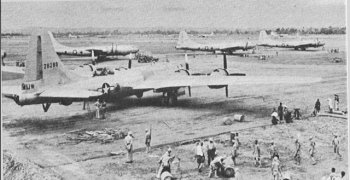![]() The Pacific War Online Encyclopedia
The Pacific War Online Encyclopedia
|
| Previous: Chengmai | Table of Contents | Next: Chennault, Claire Lee |

U.S. Army. Via ibiblio.org
Chengtu (Chengdu, 104.068E
30.653N) is located in a rich agricultural area in a rather
isolated
part of China,
the Szechuan Plain, which was readily
accessible only via the Yangtze
Gorge.
Located on the Min River valley, the city was the ancient capital of Szechuan
province and had been artificially irrigated for centuries, producing a
fertile "delta" with a population density of 2200 persons per square
mile (850 persons per square km).
By the beginning of the Pacific War, the Kuomintang government had taken refuge in nearby Chungking and Chengtu had become the site of an important airbase complex, with fields at Taipingssu (104.014E 30.602N), Fenghuangshan (104.093E 30.730N), and Shuanglin (103.948E 30.578N). However, the railroad would not reach Chengtu from Chungking until 1952.
On 10 November 1943, Roosevelt asked Chiang to have five bomber fields for B-29 Superfortresses ready at Chengtu by March 1944. Chengtu was chosen over Kweilin because of its less exposed location; Stillwell had estimated that it would take fifty Chinese divisions to protect Kweilin from the Japanese. Sites were selected at Kwanghan (Guanghan; 104.329E 30.947N), Kuinglai (Qionglai; 103.464E 30.411N), Hsinching (Xinjin; 103.846E 30.420N), and Pengshan (103.853E 30.265N). The airfields were completed using the most primitive methods and materials (due to lack of modern construction machinery) and over 300,000 conscripted laborers. The 8500' (2590m) runways were constructed on a base of sand and hand-crushed rock and surfaced with a kind of adobe rather than concrete. The fields were ready to receive bombers by 1 May 1944. The heavy use of conscription, combined with the displacement of landowners and farmers in such a densely populated area, led to considerable social upheaval. The work done by such large numbers of Chinese peasants received extensive coverage in the American press.
The unusually long runways could not be concealed from Japanese intelligence, and there were some delays bringing the fields into operation because of the necessity of building additional fighter strips for their protection. In the end, Japanese raids on the fields were less severe than anticipated.
The challenge of providing adequate logistical support at this remote location proved too great, and the B-29s were redeployed to the Marianas.
References
Craven and Cate (1952; accessed 2012-7-7)
The Pacific War Online Encyclopedia © 2007, 2011-2012 by Kent G. Budge. Index